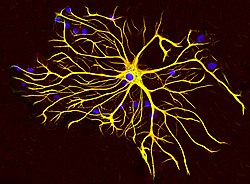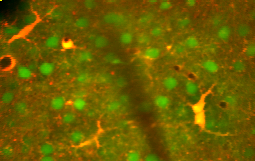Astrocytes [1] are characteristic star-shaped glial cells in the brain and spinal cord. They are also known collectively as astroglia.
| Astrocyte | |
|---|---|
 An astrocytic cell from rat brain grown in tissue culture. It is stained with antibodies. The blue material shows stained DNA, and shows the nuclei of the astrocyte and other cells. | |
| Details | |
| Location | Brain and Spinal cord |
| Identifiers | |
| Latin | Astrocytus |
| MeSH | D001253 |
| NeuroLex ID | sao1394521419 |
| TH | H2.00.06.2.00002, H2.00.06.2.01008 |
| FMA | 54537 |
| Anatomical terms of microanatomy | |

The proportion of astrocytes in the brain varies. Studies have found that the astrocyte proportion varies by region from 20% to 40% of all glia.[2]
Astrocytes do many things. They help the endothelial cells of the blood–brain barrier, provide nutrients to the nervous tissue, keep extracellular ions in balance. They also help repair the brain and spinal cord after traumatic injuries.
Research since the mid-1990s has shown that astrocytes release Ca2+ ions, and adjust brain functions.[3] Such discoveries have made astrocytes an important area of research in neuroscience.
References
change- ↑ Astro from Greek astron = star and cyte from Greek "kyttaron" = cell
- ↑ Verkhratsky A. & Butt A.M. 2013. (15 April 2013). "Numbers: how many glial cells are in the brain?". Glial physiology and pathophysiology. John Wiley and Sons. pp. 93–96. ISBN 978-0-470-97853-5.
{{cite book}}: CS1 maint: numeric names: authors list (link) - ↑ Fiacco TA, Agulhon C, McCarthy KD (2008). "Sorting out astrocyte physiology from pharmacology". Ann. Rev. Pharmacol. Toxicol. 49 (1): 151–74. doi:10.1146/annurev.pharmtox.011008.145602. PMID 18834310.
{{cite journal}}: CS1 maint: multiple names: authors list (link)